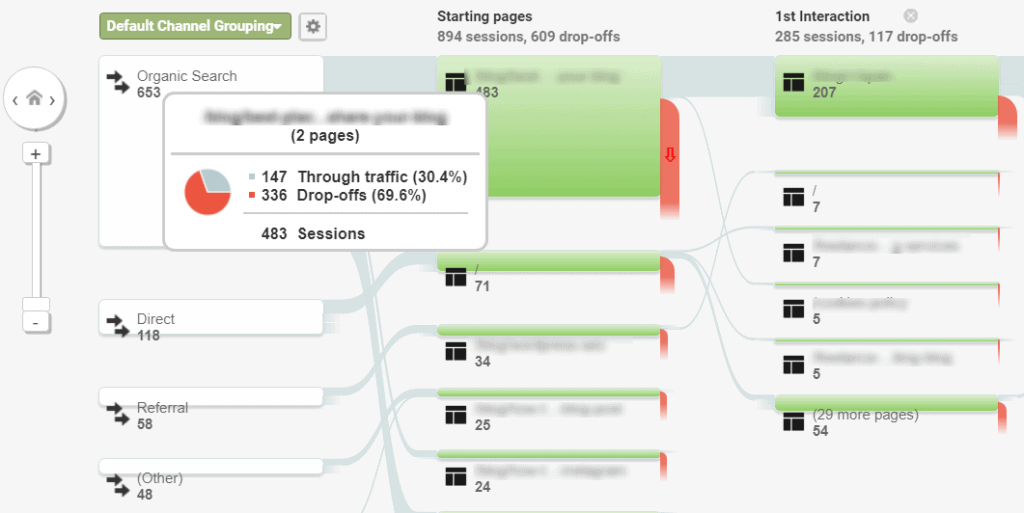Table of Contents

In digital marketing, there isn’t much room for guesswork.
The decisions you make must be based on sufficient, tangible data — from your website’s domain name all the way to the direction of your content marketing campaigns.
Unfortunately, the sheer amount of data you can track can easily turn analysis into paralysis. What you need to do is to declutter your data and zero in on the metrics that actually matter.
In this post, we will discuss the 5 most important metrics that will help you track and scale the success of your digital marketing campaigns.
Let’s get started.
1. Your Web Traffic
First and foremost, a list of important digital marketing metrics will never be complete without your web traffic. It doesn’t matter if you own a blog, an online store, or a typical business website. Getting a steady stream of traffic is one of the milestones you need to reach.
The good news is, it shouldn’t be difficult to track how many visitors or users your website gets. Google Analytics — a free marketing analytics and measurement platform — offers this data readily on the overview page of the “Audience” report.
Increasing traffic is the primary goal of a number of digital marketing strategies. This includes guest blogging, social media marketing, and paid advertising.
2. Pages Per Session
In addition to your web traffic, Google Analytics can also track several other metrics that are essential for online growth.
The number of pages per session, for example, is a direct measure of how effective your content strategy is in engaging your visitors.
Remember, if a user is satisfied with the value they received from your content, chances are they’ll browse your site for similar posts or pages that will help them keep in touch — be it an “About Us” section or a newsletter registration page.
To closely inspect how traffic flows through your website, use Google Analytics and access the “Users Flow” page from the “Audience” report. Here, you will be presented with a flowchart that shows the pages where most users normally visit and where they leave.
Analyzing the flow of traffic on your website is a great way to determine the type of content your visitors like.
Of course, you also can’t ignore the number of exits or drop-offs that specific pages are responsible for. If a certain page has substantially more visitors leaving than clicking to a different page, it may be due to the lack of a sound internal link structure or navigation.
3. Bounce Rate
The worst kind of user drop-offs are those that occur during the very first page they’ve visited. These instances are measured via the bounce rate metric, which is yet another piece of information you can obtain using Google Analytics.
Just like high drop-offs, your website’s bounce rate has a number of different causes. Apart from the lack of internal links or menus that help them discover more of your site, visitors also leave because of performance issues on your website, such as missing pages, crashes, or a slow loading speed.
Statistics show that 40 percent of users won’t think twice about abandoning a page that takes over 3 seconds to load. That’s nearly half of your potential leads leaving before you even get the chance to present your value propositions.
To measure if your website is fast enough, the best approach is to run a complete performance analysis on GTMetrix or a similar tool. It works by automatically detecting any performance-related issues on your site while providing the necessary actions that will help you fix them.
Another way to give your website the boost it needs is to leverage a CDN or Content Delivery Network. Put simply, a CDN reduces latency for users with a network of proxy servers that share the task of transferring website data across multiple locations.
4. Conversion Rate
You can have all the traffic in the world, but without paying attention to your conversion rate, it’s hard to translate your online presence into profits.
The conversion rate measures the likelihood of visitors to take action and become a subscriber, paying customer, and marketing-qualified leads. They can also be tracked on Google Analytics under the “Conversions” report after you specify your goals or enable e-commerce tracking on your account.
Your website’s conversion rate is affected by a variety of factors, including but not limited to your keyword optimization, unique selling points, and brand authority. However, it’s always a good idea to start with your on-page content if you want to lead more users down the conversion path.
Here is a rundown of the essential conversion elements that you need to prioritize:
- Headline
A punchy headline is important in grabbing the audience’s attention as well as summarizing your value propositions. Be sure it’s straightforward, compelling, and focused on the goals of your target leads. - Subheadline
The subheadline’s main purpose is to give visitors more context on your headline. You can be as descriptive as you want as long as you make the copy readable. - Call to Action
Once you pique the interest of your prospects with your headline and subheadline, the CTA should give them one final nudge into taking action. Go for action-oriented, frictionless words like “Learn,” “Start,” and “Try.”
5. Cost Per Lead
Finally, calculating the cost per lead metric makes sure your digital marketing campaigns are sustainable, scalable and, more importantly, repeatable.
It can be calculated by applying the simple formula below:
Total Marketing Expenses ÷ Total Leads Generated = Cost Per Lead
For example, if you spent $15,000 on your marketing and generated 20,000 leads in the previous month, then you have a cost per lead of $0.75.
By calculating your cost per lead, you can fine-tune your marketing budget accordingly through strategies like automation, remarketing, redefining your keyword targets, and split testing your landing pages. You may also look at opportunities to reduce costs by adopting a cheaper content development workflow and lowering your keyword bids.
Conclusion
Whatever you do, always remember that digital marketing is a numbers game.
You can’t afford to let hunches or outdated information decide your next move. Be as vigilant as possible with your data and you should be right on track for growth.











